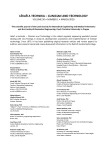FREQUENCY AND DURATION OF OXIMETER DROP-OUTS IN THE NICU: AN OBSERVATIONAL STUDY
Autoři:
Thomas Bachman; Karel Roubík
Působiště autorů:
Czech Technical University in Prague, Kladno, Czech Republic
; Department of Biomedical Technology, Faculty of Biomedical Engineering
Vyšlo v časopise:
Lékař a technika - Clinician and Technology No. 1, 2020, 50, 12-15
Kategorie:
Original research
doi:
https://doi.org/10.14311/CTJ.2020.1.02
Souhrn
Oximeters used for continuous monitoring experience periods with no signal. This SpO2 drop-out is widely acknowledged and its causes generally understood. This is a prospectively designed analysis of an existing database with the aim of characterizing drop-outs as experienced in the neonatal ICU. The data reflects 116 days of monitoring in seven tertiary care neonatal ICUs in 6 countries. From the evaluation of 1,396 drop-outs we found that typically the time was minimal with missing SpO2 data, and the episodes were short (median 2.79 minutes per day IQR 0.17–76, median 22 seconds IQR: 15–37, respectively). During about half of the days there were no prolonged dropouts (1 minute or longer), even so half of the total time spent with no SpO2 data were in prolonged episodes (median length 110 seconds IQR 85–150). The predominate factor associated with excessive drop-out time was the number of prolonged episodes rather than their duration. We concluded that the impact of drop-outs during manual control of inspired oxygen primarily impact alarm fatigue, but that during automatic FiO2 control they could have an important impact. The relative effectiveness of the fall-back strategies of these automatic control systems ought to be evaluated.
Klíčová slova:
oximeter – oxygen saturation – SpO2 drop-out
Zdroje
- Askie LM, Darlow BA, Finer N, et al. Association between oxygen saturation targeting and death or disability in extremely preterm infants in the Neonatal Oxygenation Prospective Meta-analysis Collaboration. JAMA. 2018;319(21):2190–201. DOI: 10.1001/jama.2018.5725
- Di Fiore J, Bloom J, Orge F, et al. A higher incidence of intermittent hypoxemic episodes is associated with severe retinopathy of prematurity. J Pediatr 2010;157(1):69–73. DOI: 10.1016/j.jpeds.2010.01.046
- Poets C, Roberts R, Schmidt B, et al. Association between intermittent hypoxemia or bradycardia and late death or disability in extremely preterm infants. JAMA 2015;314(6): 595–603. DOI: 10.1001/jama.2015.8841
- Ketko AK, Martin CM, Nemshak MA, et al. Balancing the tension between hyperoxia prevention and alarm fatigue in the NICU. Pediatrics 2015;136(2):496–504. DOI: 10.1542/peds.2014-1550
- Hagadorn JI, Sink DW, Buus-Frank ME, et al. Alarm safety and oxygen saturation targets in the Vermont Oxford Network iNICQ 2015 collaborative. J Perinatol 2017;37(3):270–6. DOI: 10.1038/jp.2016.219
- Mitra S, Singh B, El-Naggar W, McMillan DD. Automated versus manual control of inspired oxygen to target oxygen saturation in preterm infants: a systematic review and meta-analysis. J Perinatol. 2018;38(4):351–60. DOI: 10.1038/s41372-017-0037-z
- van Kaam, A.H., Hummler H, Wilinska M, et al. Automated versus manual oxygen control with different saturation targets and modes of respiratory support in preterm infants. J Pediatr 2015;167(3):545–50. DOI: 10.1016/j.jpeds.2015.06.012
- van den Heuvel ME, van Zanten HA, Bachman T, et al. Optimal target range of closed-loop inspired oxygen support in preterm infants: a randomized controlled study. J Pediatr 2018;197:36–41. DOI: 10.1016/j.jpeds.2018.01.077
- Wilinska M, Bachman T, Swielinski J, et al, Quicker response results in better SpO2 control – a comparison of 3 FiO2-titration strategies in ventilated preterm infants. Ann Agric Environ Med. 2015;22(4):708–12. DOI: 10.5604/12321966.1185781
- Johnson KR, Hagadorn JJ, Sink DW. Alarm Safety and Alarm Fatigue. Clin Perinatol 2017;44:713–28. DOI: 10.1016/j.clp.2017.05.005
- Lim K, Wheeler K, Jackson H, et al. Lost without trace: oximetry signal dropout in preterm infants. Arch Dis Child, 2015;100(5):435–8. DOI: 10.1136/archdischild-2014-308108
- Wilinska M, Skrzypek M, Bachman T, et al. Using the auto-mated FiO2-SpO2 control in neonatal intensive care units in Poland: a preliminary report. Developmental Period Medicine 2015;XIX,3(216).
- IEC 60601-1-10: Medical electrical equipment – Part 1-10: General requirements for basic safety and essential perfor-mance – Collateral standard: Requirements for the development of physiologic closed-loop controllers. The International Electrotechnical Commission, 2007.
Štítky
BiomedicínaČlánek vyšel v časopise
Lékař a technika

2020 Číslo 1
Nejčtenější v tomto čísle
- VERIFICATION OF CLINICAL ACCURACY OF AUTOMATED NON-INVASIVE SPHYGMOMANOMETERS: IS IT APPROPRIATE TO USE BLOOD PRESSURE SIMULATORS?
- INFLUENCE OF THE USE OF GRAVITY SETS IN A PRESSURE VOLUMETRIC INFUSION PUMP WITH AN IMPACT ON THE ACCURACY OF INFUSION SOLUTION FLOWS
- FUNCTIONALIZATION OF POLYMERIC NANOFIBERS USING PLATELETS FOR MELANOCYTE CULTURE
- FREQUENCY AND DURATION OF OXIMETER DROP-OUTS IN THE NICU: AN OBSERVATIONAL STUDY
